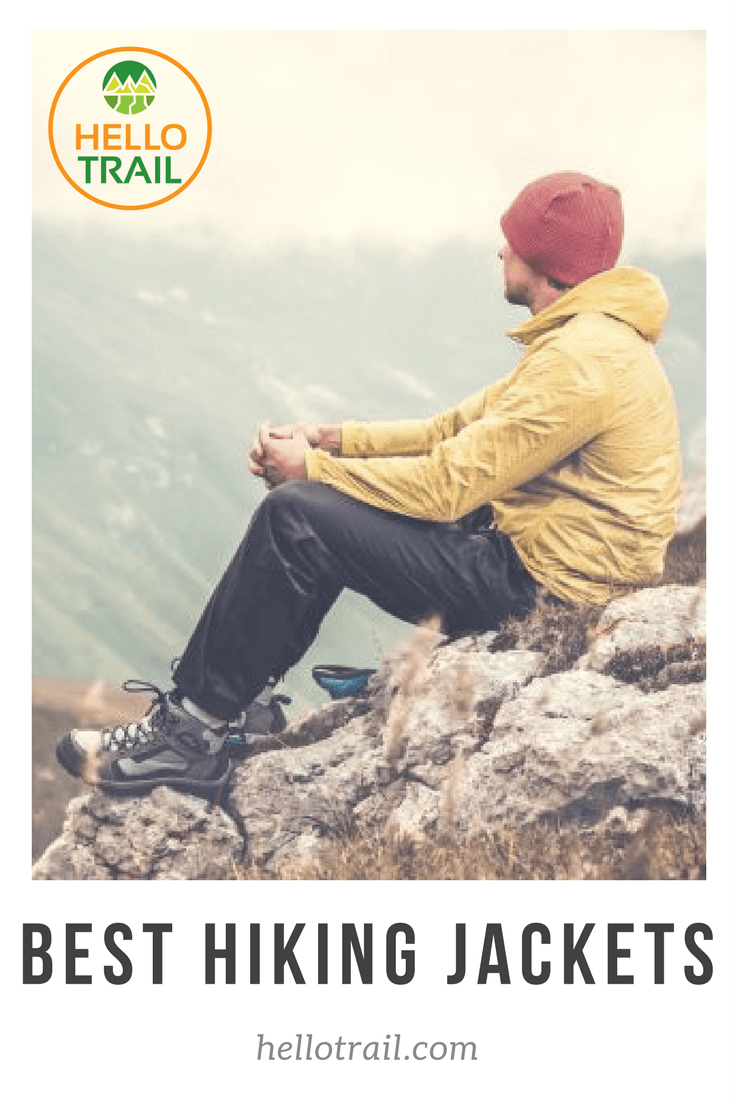Your hiking apparel is just as important as your boots, backpack, and GPS gadgets. Proper outerwear will enhance your experience on the trail by keeping you warm, dry, and protected from the elements.
Let’s look at 4 of the best hiking jackets for women and men so that you don’t get caught out in nature unprepared and maybe even stay dry…
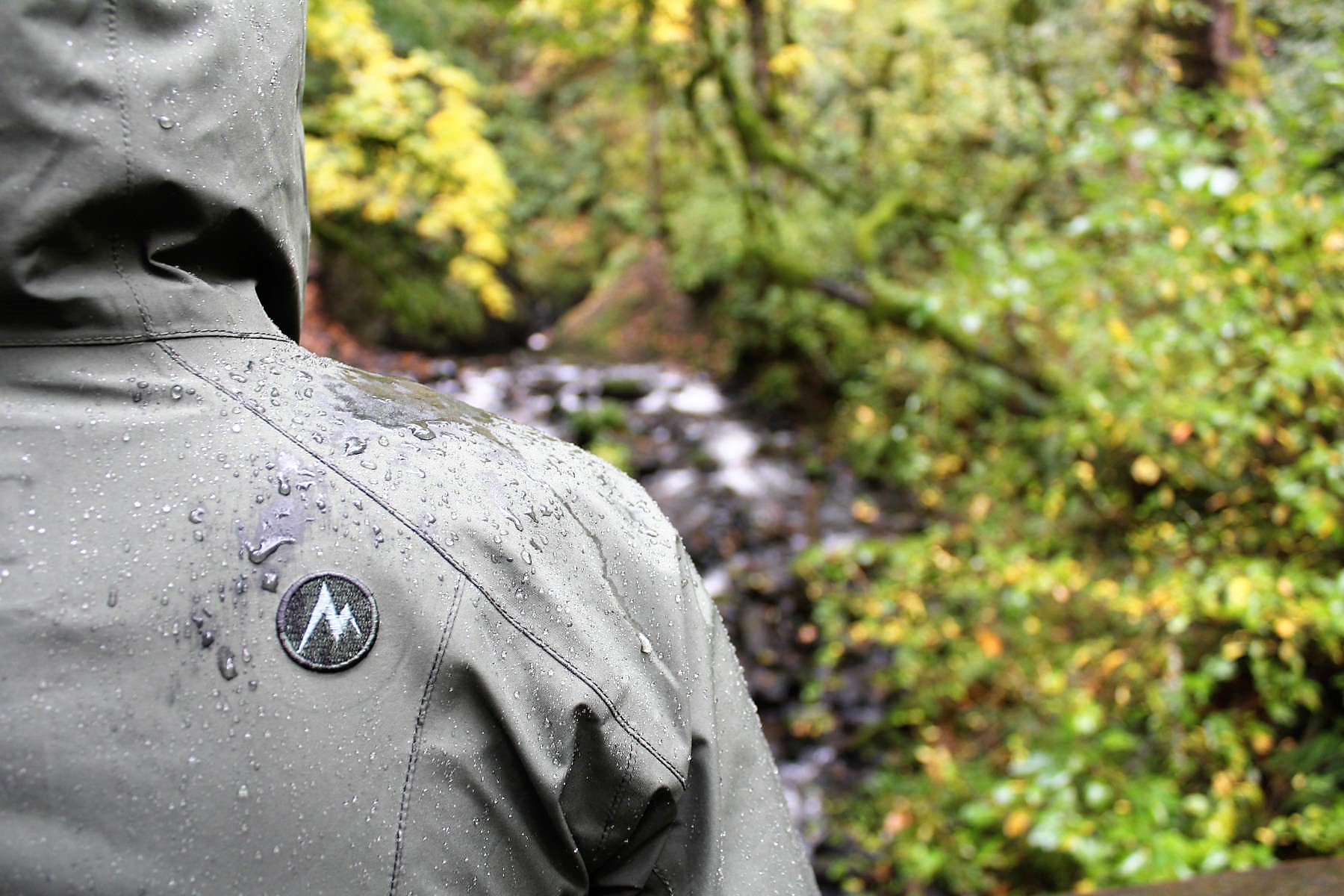
HelloTrail® is reader-supported. We may earn a commission, at no additional cost to you, on purchases made from our expert chosen links.
What are the Best Hiking Jackets for 2023?
Marmot Precip Jacket
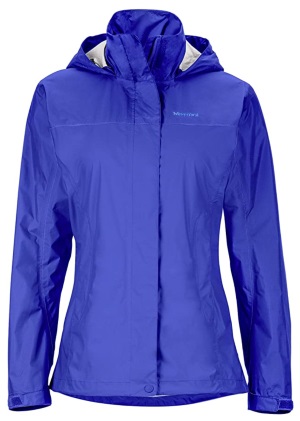
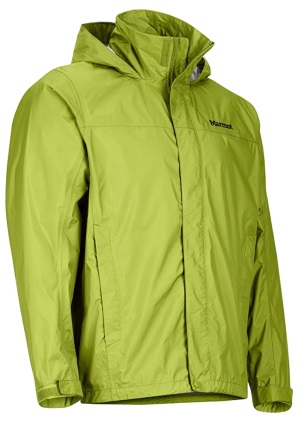
Marmot designed the PreCip jacket in both women’s and men’s versions for excellent rain protection at an affordable price.
The newly engineered NanoPro fabric is completely waterproof and more breathable than ever before.
This jacket boasts a combination of durability, compressibility, and lightweight, tipping the scales at just 11.4 ounces for the women’s version and 13 ounces for the men’s.
Women’s
Men’s
The 2.5 layer construction and DryTouch finish ensure you won’t feel the clamminess often created by rain shells. Marmot’s Angel Wing Movement allows for a full range of arm motion and ensures you won’t feel restricted while on the go.
The jacket includes a hood, pit zips for adequate ventilation, and a storm flap over the front zipper.
The Marmot Precip jacket integrates an adjustable hem and adjustable Velcro cuffs. It compresses and packs up into its pocket, ensuring it won’t take up too much precious space in your pack.
Pros
– Waterproof & Breathable
– Adjustable hood
– Stuffs into its pocket
Cons
– No interior pockets for extra storage
– No insulation
Columbia Lhotse II Interchange
The Columbia Lhotse Interchange jacket is a three-in-one option that is extremely versatile, making for a coveted trail companion you can utilize in varying weather conditions.
The outer shell is 100% nylon Omni-Shield double ripstop, the inner lining is made from Taffeta (think silky soft!), and the innermost liner is constructed from Dotswarm fleece.

Columbia has integrated its proprietary Omni-Heat thermal reflective layer to keep you toasty in cold weather. The Lhotse II jacket has an easy-to-use zipper interchange system.
The jacket features an adjustable storm hood, zippered hand pockets, an interior security pocket for stuffing essentials, and adjustable cuffs.
Pros
– Three-In-One versatile hiking jacket
– Waterproof & Breathable
– Underarm venting – Trust me, you’ll appreciate that
Cons
– Arms aren’t insulated as much as the body
– No lining in the hood
Columbia Bugaboo II Fleece Interchange
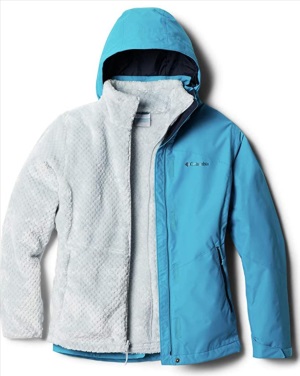
The women’s Columbia Bugaboo II Interchange jacket is similar to the men’s Lhotse II with an attractive, women’s specific fit.
Columbia’s patented Omni-Heat thermal reflective technology keeps you warm during winter hikes, and the Omni-Tech waterproof breathable shell ensures you’re kept dry during the most torrential downpours.
This Columbia Bugaboo jacket is designed for whatever the weather throws at you — and on warm days, you can strip down to the fleece liner.
The adjustable storm hood is also removable if you’re looking to go a little more lightweight.
Hand pockets with zippers and an interior security pocket compliment this jacket’s wide range of features. The Columbia Bugaboo Interchange is the epitome of versatility.
Pros
– Three-In-One design allows the two layers to be their own outerwear if needed
– Interior security pocket
Cons
– No underarm vent zippers
The North Face Apex Bionic Softshell

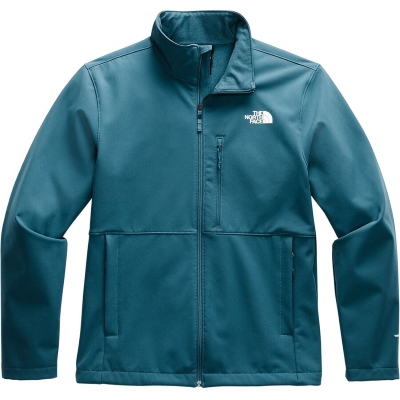
North Face’s Apex Bionic softshell was designed specifically for cold and windy conditions.
This softshell features the company’s Windwall fabric, which is a wind-resistant fleece.
The North Face Apex fabric limits the permeability of external air, reducing the effects of windchill, maintaining warmth, and ensuring comfort.
Women’s
Men’s
The men’s version features a relaxed fit, while the women’s version is more streamlined, serving for a more active fit. Both models boast a center zip, zip chest pocket, and zip hand pockets.
The North Face Apex Bionic jacket is the ultimate softshell for when you’re working hard out on the trail and need a blend of comfort and weather resistance.
Pros
– Windproof & Water repellent
– The athletic fit of the women’s version makes it an excellent option for layering
– Fleece-lined outer chest pocket perfect for small items or your smartphone
Cons
– Hiking in temps below 40f? Look for some extra insulation
– Men’s version is a more relaxed fit
– No internal pockets
What to Look for Before You Buy
Types of Jackets
There aren’t many jackets that do-it-all on the trail. Most serve specific purposes, and layering techniques are the key to comfort.
You’re likely going to have multiple jackets in your gear arsenal, and you’ll have to make the decision which one(s) you will bring along on each expedition.
Rain Shells
Rain shells are waterproof jackets intended to be worn over other layers, serving as your first line of defense when conditions turn rainy.
Some are designed for hiking and daily use, others are more specific lightweight products, and some are performance-oriented.
Rain shells need to resist moisture yet also let out hot air through venting mechanisms. They have multiple fabric layers for breathability purposes.
Most rain jackets have a hood and pit or side zips for venting which comes in handy on spring hikes.
Softshell Jackets
Softshells are flexible outer layers worn in place of high-performance hardshell jackets. Most are made with woven nylon or polyester. Softshell jackets are not meant to withstand the elements as much as they’re intended for mobility and breathability when you’re working hard.
Performance softshells are designed for specific activities such as climbing, skiing, or mountaineering. Some softshells are DWR treated, providing a certain level of water resistance, but they are no substitute for a high-end hardshell or rain jacket.
Softshell jackets do provide a decent level of wind protection. Some versions provide no insulation, while others offer thick, fleece-lined warmth. A softshell’s greatest advantage is its stretchiness, and some softshells are available with hoods.
Hardshell Jackets
Hardshell jackets, by definition, offer high levels of windproofing and waterproofing, designed for nature’s harshest conditions. Most hardshell jackets boast a 3-layer construction that includes an interior liner for breathability and an exterior face fabric for protection from the wind and rain.
These jackets are commonly used in mountaineering, skiing, alpine, and ice climbing — but can also come in handy on a winter hike. Hardshell jackets typically include a hood, side or pit vents and can be placed into different categories: alpine, all-around, or minimalist.
Ultralight hikers might prefer minimalist versions, while those embarking on winter hikes that include scrambling over rocks might opt for an alpine version.
Interchangeable Jackets
Interchangeable jackets are multipurpose — typically a softshell and a hardshell built into one product, protecting from the elements in addition to insulation. You can wear both simultaneously or just one or the other — depending on the conditions.
These types of interchangeable jackets offer the greatest versatility and are preferred by many hikers for this reason. In warm conditions, you can hike in the baseliner alone, and then if it starts raining, pull out the hard shell and layer it over the liner to serve as a rain jacket.
In cold conditions, you might want to wear both for a combination of insulation and weather resistance. The internal jacket is typically zipped into the outer layer, but it doesn’t have to be. If you prefer an ultralight shell, you might have sacrifice features such as pockets.
Hiking Jacket Features
When picking out a hiking jacket, you need to determine which features are important to you.
- Do you like a jacket with plenty of pockets for storing essentials?
- Do you prefer a hood, or would you rather go without?
- For those who tend to run hot, ventilation is a huge consideration.
- Does your jacket come with side or pit zips?
If you like versatility, an interchangeable jacket might be the way to go, offering the ability to transition between different types of jackets depending on weather conditions. Consider the type of weather you’ll be hiking in.
In rainy climates, a rain shell with a hood is essential, and you might prefer your softshell have a hood as well for hiking during a drizzle. Evaluate the features you need and what you’re willing to go without.
Wrapping It Up…
Most hikers don’t intend on getting caught out in the rain — but if you do, you need to be prepared so that your hiking experience doesn’t end up a miserable outing. Having the right clothes and gear is critical.
Hiking in the rain or during high wind gusts is not ideal — but if you have the best hiking jacket for the conditions, it won’t be so bad, either. Every type of climate boasts positive and negative aspects and the important thing is to be prepared for what may come your way.
The ability to choose between different jackets is ideal — but if you prefer to bring along just one, an interchangeable option might be the way to go. In the end, it all comes down to personal preference.
We’ve provided you with enough options in this article that you should be able to find what you need and get out there — the trails are calling.
